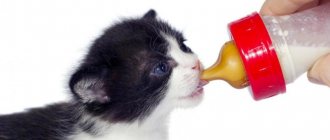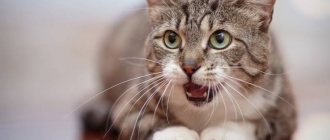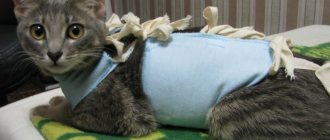An X-ray of a cat or dog is performed in a veterinary clinic using special equipment. X-rays of the chest or other bones are used for suspected fractures, serious illnesses, and in other cases. The technique can be performed with contrast, with minimal impact on the cat’s body. The diagnostic procedure is carried out on kittens and adults only as prescribed by a veterinarian.
In what cases is it indicated?
A digital x-ray of the chest, posterior region or tail is performed in a veterinary clinic if indicated. Although the procedure is safe, it still has a slight effect on the condition of a healthy cat. It is worth examining the lungs, spine and other structures using x-rays in animals in the following cases:
- Mechanical damage. If a cat has a suspected bone or tail fracture, dislocation or joint injury, it is recommended to take an x-ray to confirm/refute the diagnosis.
- Respiratory diseases and inflammatory reactions in the trachea, bronchi or lungs.
- Falling from a window after a traffic accident.
- Malignant tumor in a cat of different localization.
- Impaired heart function.
- Suspicion of intestinal obstruction. The problem may be associated with a foreign object entering the gastrointestinal tract, as a result of which it is worth taking an x-ray of the stomach and other digestive organs.
- Enlargement or curvature of the pancreas.
- Formation of kidney stones.
- Disturbed structure of the urinary system organs.
- Suspicion of porto-systemic shunt. In a cat, the pathology is characterized by a congenital defect, as a result of which an extra vessel is present.
- During pregnancy in a cat. In a healthy individual, manipulation is performed to determine the number of kittens.
Veterinarians recommend X-raying a cat if spinal cord compression is suspected. In case of such a violation, such a diagnostic technique is the most informative.
Why you shouldn’t be afraid to undergo a CT/PET scan during quarantine
A visit to a medical center for a CT/PET examination will be safe without the risk of contracting coronavirus if you follow simple preventive measures:
- Before leaving home:
- It is better to refuse public transport, use a personal car or, as a last resort, a taxi.
- If you have to use public transport
: keep a distance from passengers of at least 1 -1.5 m, - put on a mask, take antiseptic and gloves with you.
- If you get to the medical center on foot, this is the best option; there are few people on the street now, so you don’t need to use a medical mask, because... it is only needed to protect against an infected person when he sneezes or coughs.
- At the medical center:
- Arrive for the examination exactly at the appointed time with a small margin of 5-7 minutes for paperwork to avoid a long wait.
- Use a tissue or glove when opening doors.
- Touch less surfaces and objects in the reception area and doctor's office.
- Do not touch your face, nose, eyes, lips with your hands.
- Communicate with staff at a distance of at least 1 -1.5 m
- There is no danger for you in the room where the tomograph is located, because the couch on which you will be asked to lie has been pre-treated; there will be no direct contact of the body with foreign objects, because You remain in your clothes if there are no metal objects on them, or you will be offered disposable medical clothing.
- After completing the diagnostics:
- Immediately after the scan is completed, you can leave the clinic; there is no need to wait for the results to be deciphered and the report issued. Just tell the center staff your contacts or the contacts of your attending physician, where you can send the results of the study electronically.
- If you need to go into a doctor's office or restroom, use a tissue to open the door and wash your hands with an antibacterial solution.
- Upon returning home, wash your hands thoroughly with soap and use an alcohol-based antiseptic. Don't forget about your face and nasal rinsing.
After washing your hands, you must use a skin antiseptic - If, after a CT/PET scan, you need to consult with your doctor based on the results of the examination, it is better to arrange a remote consultation by phone or video call.
| The distance between people during the epidemic should be at least 1 -1.5 m |
Medical centers are also worried about infection safety rules during the epidemic
, which is regulated by federal and regional orders of the ministries of health, the order of the Chief Sanitary Inspector, the Resolution of Rospotrebnadzor and other mandatory documents:
- During the day, all work surfaces and objects that come into contact with other people are treated several times with a disinfectant solution.
Treating all work surfaces with a disinfectant solution - After each patient, the tomograph couch and its internal surfaces are disinfected, and the room is wet cleaned.
Cleaning medical equipment after each use - Medical personnel follow all WHO recommendations for personal prevention of coronavirus infection.
Features of preparation
Before the barium test, the pet must first take Espumisan.
If an x-ray of a cat’s skull or other organs is done urgently, then no preparatory procedures are performed. If a diagnostic procedure with barium is planned in advance, then you need to know how to prepare your pet for it. The veterinarian can prescribe Espumisan to the cat, which is taken three times a day, 1-2 capsules. Such a preparatory measure before performing the manipulation is prescribed in the case of diagnosing the spinal column, bone structures of the pelvic floor, femur and humerus, as well as the abdominal cavity and lungs in cats. Preparation is required to reduce the accumulation of gases in different parts of the stomach and intestines. If there is excessive gas formation, the images may be inaccurate, causing the final results to be distorted. If an x-ray with a contrast agent is performed without anesthesia, it is recommended that the owners be present to fix the animal in the required position.
Indications
- chronic constipation;
- feeling of abdominal distension;
- increased gas formation;
- feeling of incomplete bowel movement;
- repeated episodes of nausea, vomiting, regurgitation that are not caused by an acute infectious process;
- rapid weight loss not associated with dietary restrictions.
Carrying out this study in the group of diseases included in the concept of “acute abdomen”, as well as bleeding of any localization, is contraindicated. The entry of the barium mixture into the blood or its leakage into the abdominal cavity worsens the patient's condition and can lead to death in the absence of emergency medical care.
How do they do it?
Since taking x-rays requires the use of special equipment, it cannot be performed at home; the procedure is performed exclusively in a veterinary clinic. In rare cases, x-rays of a cat's paw or other areas of the body are performed under local anesthesia. Most often, 2-3 people are involved in performing the manipulation, who could provide the pet with a motionless body position so that the specialist can take high-quality photographs. The duration of the diagnostic procedure is no more than a quarter of an hour, and the cat does not experience pain or other unpleasant sensations when performing an x-ray. The advantage of this diagnostic technique is the ability to carry it out at any time without prior preparation. For a more accurate clinical picture of the pathology, the pet is often given barium sulfate to drink. This procedure is often performed when examining the stomach for the presence of a foreign body. X-ray is performed as follows:
First, the animal must be laid down and secured on the table.
- The owners fix the cat on a special table. Some veterinary clinics provide special protective equipment (aprons or collars) so that owners remain clean during the procedure. If the doctor deems it necessary, the x-ray is performed under local anesthesia.
- The specialist sets up the x-ray and takes several pictures. For injuries, a direct, posterior or lateral projection is performed.
- The cat is released and the veterinarian deciphers the results of the diagnostic examination to the owners. The specialist determines how far the indicators are from the norm and, if necessary, prescribes treatment.
What to do if you get sick with coronavirus and where to call - step-by-step instructions
When a person exhibits symptoms of coronavirus, one should not panic. First of all, you need to take your temperature and calmly assess your own condition. If everything is not critical, you need to contact the phone number of the clinic to which the person is assigned. They will record the information and refer a doctor. Further instructions are as follows:
It is necessary to compile a list of all persons with whom there have been contacts over the last 2 weeks with the widest possible information - names, surnames, telephone numbers, residential addresses, places of work, etc. It should be supplemented with an indication of all places that were visited - including including cafes, shops and other establishments. Medical service representatives will take materials to conduct coronavirus tests. Usually this is a swab from the nasopharyngeal mucosa. Until the result is obtained, quarantine measures are introduced - restriction of movement and contact, as well as additional monitoring of the condition. At home, you need to continue to follow all basic safety measures - wash your hands, do wet cleaning and regularly ventilate the room
It is also important to follow your doctor's treatment recommendations and monitor the condition of family members. During this time, products should be delivered by volunteers, friends or relatives in a non-contact manner.
Is the procedure harmful?
Some owners believe that X-raying the head of a cat or dog is not safe and has a negative impact on the health of the pet. This information is untrue, since during manipulation the radiation occurs in a minimal amount, which does not in any way affect the condition of the pet. In addition, a disease that was not diagnosed in time using x-rays or other diagnostic methods can pose a greater danger than the influence of x-rays.
Modern veterinary clinics use special X-ray equipment to protect the cat from scattered radiation.
When should a CT scan of the lungs be done during coronavirus?
According to the accepted classification of identified pathological changes, standard “CT1” corresponds to less than 25% lung damage, “CT2” - 35-50%, “CT3” - 50-75%, “CT4” - 75% or more. The peculiarity of pneumonia caused by the new coronavirus COVID-19 is that the complication progresses quickly to a more severe form.
Unlike X-rays, CT will show lung damage of 5% or less - the radiologist sees even single areas of infiltration with a diameter of 4-5 mm. Pneumonia corresponding to CT1, and sometimes CT2, cannot be determined from an x-ray. If you have characteristic symptoms, even mild ones, and test positive for COVID-19, there is no need to wait for the infection to spread more intensely and cause damage to large areas of the lungs.
CT scan of the lungs is indicated for:
- Temperature 38 degrees;
- Respiratory rate > 22 per minute;
- shortness of breath/cough/chest pain;
- Blood saturation
A CT scan for coronavirus is done even if the test for COVID-19 shows a negative result, and the x-ray does not reveal significant changes in the lung tissue (the lesions may still be small, there may be artifacts and shadows in the image) - while the patient is concerned about the above symptoms , contact with patients in the past is not excluded.
Benefits of manipulation
It is not for nothing that such a diagnostic technique for any cat pathology is one of the most popular, since it has a lot of positive aspects. With an x-ray, it is possible to separate the image and identify pathology in the lower and upper areas, while it is possible to zoom in on the image in order to more accurately examine the pathological areas. It is also possible to make a recording in real time, which will display the work of internal organs. Based on the X-ray results, the specialist assesses the clinical picture as accurately as possible and selects individual therapy for the cat.
Who should not have a CT scan and when?
CT scans are performed for children only in case of serious illnesses.
Tomography is strictly prohibited for pregnant women and is allowed only if necessary for children.
With “contrast” - iodine-containing drugs - there are much more restrictions.
In addition to those diseases for which it is expressly prohibited to take iodine-containing drugs, this type of examination is contraindicated for diabetics, persons with a body weight exceeding that allowed for the device, and patients in severe conditions, if the risk of the examination outweighs the benefit.
For everyone else, it can be done without fear - but only taking into account the total annual radiation dose, which should include flights, X-ray examinations and all other cases of interaction with ionizing radiation.
There are few of them in our lives, but they still exist.
About the service
Radiography is a way to make a diagnosis by taking pictures of the organs or tissues of a living being. X-rays penetrate the body through the skin into the organ being examined or a specific area of the cat’s internal system. Thanks to the resulting image, the doctor obtains the necessary information and draws conclusions.
The rays penetrate somewhat unevenly, in some tissues it is easier, and in others it is more difficult. For example, when passing through the lungs, the gastrointestinal tract at the time of gas formation, the trachea there are no obstacles. But bones and other dense tissues create a kind of barrier for the rays. Thus, a drawing appears on a special film, which serves as the basis for analyzing the state of a living organism and making a diagnosis. The size and breed of the cat do not matter.











